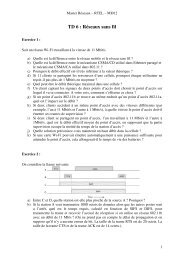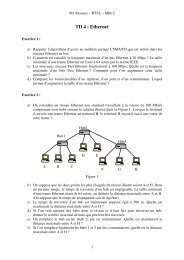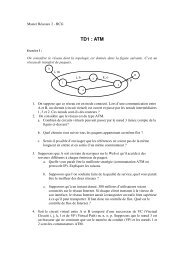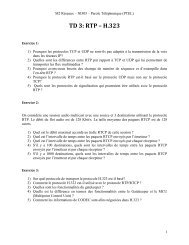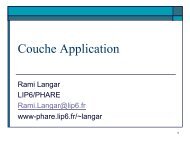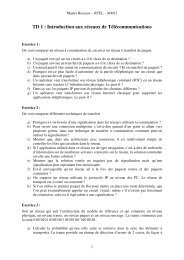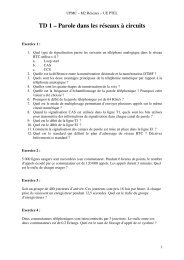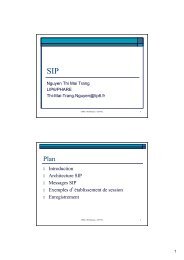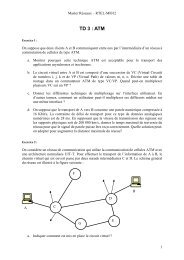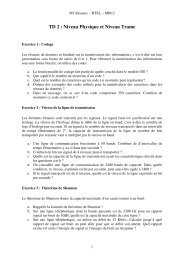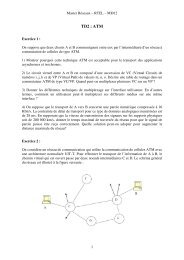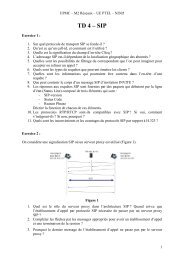VoIP_H323_RTP - 08.pdf - Phare - LIP6
VoIP_H323_RTP - 08.pdf - Phare - LIP6
VoIP_H323_RTP - 08.pdf - Phare - LIP6
You also want an ePaper? Increase the reach of your titles
YUMPU automatically turns print PDFs into web optimized ePapers that Google loves.
Master Réseaux – PTEL 2008/2009<br />
Voice over IP:<br />
<strong>H323</strong> & <strong>RTP</strong>/RTCP<br />
Rami Langar<br />
PHARE research Team<br />
rami.langar@lip6.fr<br />
15 Décembre, 2008<br />
1
Plan<br />
H.323<br />
• Overview : <strong>VoIP</strong><br />
• H.323 Entities<br />
• H.323 Signaling models<br />
• H.323 Call processing steps<br />
<strong>RTP</strong>/RTCP<br />
• Overview : UDP, TCP<br />
• <strong>RTP</strong> & Multimedia applications<br />
• RTCP objectives<br />
2
What is <strong>VoIP</strong>?<br />
<br />
<strong>VoIP</strong> (Voice over Internet Protocol), sometimes<br />
referred to as Internet telephony, is a method of<br />
digitizing voice, encapsulating the digitized voice into<br />
packets and transmitting those packets over a<br />
packet switched IP network.<br />
Categories of <strong>VoIP</strong> :<br />
• Private and Desktop: Skype, Microsoft Netmeeting,<br />
gphone, Marratech, etc.<br />
• Enterprise : Small IP phone deployments, IP PBX,<br />
Cisco Callmanager.<br />
• ISP/Carrier : Toll Bypass services, VOIP wholesale,<br />
using equipment by vendors such as Cisco, Lucent,<br />
Avaya, etc.<br />
3
Voice over IP - the basics<br />
Most implementations use H.323 protocol<br />
• An ITU-T standard for bi-directional<br />
exchange of voice, video, and data<br />
• Applies to an IP network<br />
• H.323 is a set of standards for group<br />
communication<br />
• Uses TCP for call setup & control<br />
• Traffic is actually carried on <strong>RTP</strong> (Real Time<br />
Protocol) which runs on top of UDP.<br />
4
<strong>VoIP</strong> Protocols<br />
H.323 Multimedia Standard<br />
• H.225 RAS - Registration, Admission,<br />
Status<br />
• Q.931 - Call Signaling (Setup &<br />
Termination)<br />
• H.245 – Media flow Control (Preferences,<br />
Capability exchange, etc.)<br />
• Lots of G.7XX CODECS for audio<br />
SIP – Session Initialization Protocol<br />
• Covered in earlier course<br />
5
Here’s how it stacks up:<br />
H.323 Multimedia Protocol<br />
H.225 Call setup & control – RAS (Q.931)<br />
H.235 Security & Authentication<br />
H.245 Call negotiation, capability exchange<br />
H.450 Other supplemental Services<br />
H.246 Circuit Switched Network Interop.<br />
H.332 Conferencing<br />
H.26X Video CODECS<br />
G.7XX Audio CODECS<br />
6
How they fit in: The ISO Model<br />
ISO Model<br />
Layer<br />
Presentation<br />
Session<br />
Transport<br />
Network<br />
Data Link<br />
Protocol or Standard<br />
Applications / CODECS<br />
H.323 & SIP<br />
<strong>RTP</strong> / UDP / TCP<br />
IP – Non QOS<br />
ATM, FR, PPP, Ethernet<br />
7
<strong>H323</strong> – Protocol Stack<br />
8
Comparison of Packet vs. Circuit Switching<br />
Circuit<br />
Call Setup Database /<br />
Communications<br />
Channel<br />
SS 7 Overlay<br />
Dedicated<br />
Packet<br />
H.323 & SIP<br />
Shared<br />
Addressing NANP IPv4 & IPv6<br />
9
H.323 Entities<br />
Terminal<br />
Terminal<br />
Gatekeeper<br />
Réseaux IP<br />
MCU<br />
Gateway<br />
RTC<br />
RNIS<br />
10
H.323 Equipment<br />
Gateway<br />
• Device that connects H.323 voice network to<br />
non-H.323 voice network (SIP or PSTN)<br />
• Allows H.323 terminals to communication with<br />
non-H.323 terminals<br />
Gatekeeper<br />
• Provides address translation (H.323 & E.164 to<br />
IP)<br />
• Admission control for H.323 terminals and<br />
gateways<br />
• Manage bandwidth allocation<br />
• Other optional services<br />
11
H.323 Equipment<br />
MCU - Multipoint Control Unit<br />
• Endpoint that supports conferences between 3 or more<br />
endpoints<br />
• Can be stand-alone device (e.g., PC) or integrated into a<br />
gateway, gatekeeper or terminal<br />
• Typically consists of multi-point controller (MC) and<br />
multi-point processor (MP)<br />
MC : Multipoint Controller - handles control and<br />
signalling for conference support<br />
MP : Multipoint Processor - receives streams from<br />
endpoints, processes them, and returns them to the<br />
endpoints in the conference<br />
12
H.323 Equipment<br />
<br />
<br />
<br />
An endpoint that<br />
supports 2-way<br />
streaming with<br />
another H.323<br />
terminal or gateway<br />
Originates and<br />
terminates calls<br />
Includes<br />
videoconferencing<br />
stations, hard<br />
phones, & soft<br />
phones<br />
13
Signaling Models<br />
Determines which protocol messages pass<br />
through the gatekeeper, and which pass directly<br />
between the two endpoints<br />
The more messages that are routed between the<br />
gatekeeper, the more the load and responsibility<br />
(more information and more control)<br />
The gatekeeper ultimately decides on the<br />
signalling model<br />
Media stream (<strong>RTP</strong>) never passes through the<br />
gatekeeper function
Direct Endpoint Call Signalling
Gatekeeper Routed Call Signalling (Q.931/H.245)<br />
16
H.225 RAS - Discovery<br />
Registration, Admission and Status (RAS), defined<br />
in ITU-T H.225<br />
RAS is responsible for registration, admission, and<br />
disengaging procedures between H.323 endpoint<br />
and the Gatekeeper of H.323 zone they are<br />
assigned to.<br />
Gatekeeper Discovery: GRQ, GCF, GRJ.<br />
• Unicast Discovery. Endpoint knows GK IP<br />
address & register directly using UDP port 1719<br />
• Multicast using UDP multicast address<br />
224.0.1.41 with UDP port 1718<br />
17
Automatic Gatekeeper Discovery<br />
18
H.225 RAS - Registration<br />
Registration with Gatekeeper using its<br />
alias or E.164 address<br />
• RRQ Registration Request using UDP port<br />
1719 : contains transport address to be<br />
used for the call setup.<br />
• RCF Registration Confirm : includes<br />
terminal ID.<br />
• RRJ Registration Reject<br />
• URQ Un-registration Request<br />
• URF Un-registration Confirm<br />
19
Endpoint Registration<br />
20
H.225 RAS – Call admission<br />
ARQ – admission request<br />
• Terminal A requests admission to make a call.<br />
• Message sent to Gatekeeper :<br />
Seq. num, Terminal ID, Dest. Info, CRV, BW<br />
estimation.<br />
ACF – admission confirm<br />
• Mode used for the call (routed/direct).<br />
• Gatekeeper responds with IP address of the<br />
destination terminal or the destination gateway<br />
(if terminal is analog).<br />
• Authorized BW.<br />
21
Endpoint Admission To Network<br />
22
H.323 – Call setup (Q.931)<br />
First TCP connection: Established between<br />
the caller and called user using the port<br />
1720 : Call signaling channel.<br />
• Setup<br />
Indicates H.323 party wants to setup a<br />
connection to called party<br />
• Alerting<br />
Called user has been alerted, (phone is ringing)<br />
• Connect<br />
Acceptance of call by called party specifying the<br />
H.245 call control channel for capabilities<br />
exchange<br />
• Release complete<br />
H.225 (Q.931) call has been released, signaling<br />
channel is now closed.<br />
23
H.323 – H.245 channel control<br />
Caller establishes logical channels for<br />
transmission of H.323 data using a second<br />
TCP connection<br />
Negotiates:<br />
• channel usage<br />
• master/slave configuration<br />
• flow control<br />
• Codec used.<br />
Messages follow the recommendation H.245<br />
using TCP ports:<br />
• 1024-5000 ports in Cisco implementation<br />
24
H.323 – H.245 Messages<br />
Terminal Capability Set message<br />
• Contains information on a terminal’s ability to send<br />
and receive multimedia streams<br />
• If conferencing, determination of MCU is<br />
negotiated during this phase<br />
• After capabilities exchange, clients have a<br />
compatible method for transmitting media<br />
streams; multimedia communication channels can<br />
be opened<br />
Master/Slave Determination<br />
• Determines which terminal will be master which<br />
will be slave in the call<br />
25
H.323 – H.245 Channel Control<br />
Terminal A<br />
Alias:<br />
A@domain1.com<br />
Canal de Controle<br />
H.245<br />
TCP<br />
H.245: Terminal Capability Set<br />
Multiplex capability<br />
Capability Table:<br />
H.261 video<br />
G.711, G.729<br />
Terminal Capability Set<br />
Terminal Capability Set Ack<br />
Terminal Capability Set<br />
…Ack<br />
Terminal B<br />
Alias:<br />
B@domain2.com<br />
Canal de Controle<br />
H.245<br />
TCP 8741<br />
H.245: Terminal Capability Set<br />
Multiplex capability<br />
Capability Table:<br />
H.261 video<br />
G.711, Alaw64k<br />
26
H.323 – H.245 Channel Control<br />
Terminal A<br />
Alias:<br />
A@domain1.com<br />
H.245: OpenLogicalChannel<br />
LogicalChannel 1,<br />
RTCP RR port 7771<br />
Session number, <strong>RTP</strong> PT, …<br />
OpenLogicalChannel<br />
Terminal B<br />
Alias:<br />
B@domain2.com<br />
Canal de Controle<br />
H.245<br />
TCP<br />
OpenLogicalChannel<br />
…Ack<br />
…Ack<br />
Canal de Controle<br />
H.245<br />
TCP 8741<br />
H.245: OpenLogicalChannelAck<br />
LogicalChannel 1,<br />
RTCP SR port 9345,<br />
<strong>RTP</strong> port 9344<br />
27
H.323 – Conversation<br />
Terminal A<br />
Alias:<br />
A@domain1.com<br />
Terminal B<br />
Alias:<br />
B@domain2.com<br />
Canaux audio<br />
<strong>RTP</strong> : UDP<br />
RTCP : UDP 7771<br />
RTCP : UDP<br />
Flux <strong>RTP</strong> de A vers B<br />
RTCP RR<br />
RTCP SR<br />
Canaux audio<br />
<strong>RTP</strong> : UDP 9344<br />
RTCP : UDP<br />
RTCP : UDP 9345<br />
28
Call termination<br />
Client A completes transmission of media and<br />
closes logical channels used to transmit media<br />
• Close Logical Channel message initiated (H.245).<br />
• Client A transmits End Session Command (H.245)<br />
• Client B closes media logical channels and transmits<br />
End Session Command<br />
• Client A closes H.245 control channel<br />
• If call signaling channel is still open, a Release<br />
Complete message (H.225) is sent between clients<br />
to close this channel<br />
• Disengage Request (DRQ) and disengage confirm<br />
(DCF) between terminal – GK, and Gateway – GK.<br />
29
Call termination<br />
Terminal GK Gateway<br />
2<br />
3<br />
1<br />
2<br />
3<br />
1 : Release Complete<br />
2 : DRQ<br />
3 : DCF<br />
30
H.323 Model<br />
31
<strong>RTP</strong>/RTCP details<br />
32
Application taxonomy<br />
<br />
<br />
<br />
<br />
<br />
Elastic applications<br />
A user waits for info from a<br />
server.<br />
Small end-to-end delay<br />
preferred (non<br />
fundamental)<br />
Instantaneous bit rate<br />
required: low<br />
Packet losses recovered by<br />
the transport protocol<br />
through retransmission<br />
• End-to-end delay<br />
increases<br />
Multimedia applications<br />
Two users interact (in real<br />
time)<br />
Low delay fundamental (a<br />
delayed packet is<br />
equivalent to a lost packet)<br />
Required bit-rate may be<br />
significant<br />
May be robust to (limited)<br />
packet losses<br />
33
Applications and protocol stack<br />
34
UDP protocol<br />
UDP (User Datagram Protocol ) permits application to<br />
application (host to host) communication through<br />
datagram transmission<br />
UDP provides a layer 4 service:<br />
• Connectionless (out of sequence packets)<br />
• Unreliable (packet lost)<br />
• Low overhead<br />
• Optional checksum<br />
Application identification through :<br />
• Source IP address, destination IP address, source UDP<br />
port, destination UDP port<br />
• No rate control<br />
<br />
<br />
No flow control (possible receiver saturation)<br />
No congestion control<br />
35
UDP packet format<br />
36
TCP protocol<br />
TCP (Transmission Control Protocol ) is the<br />
other Internet layer 4 protocol<br />
Main characteristics<br />
• Connection-oriented<br />
• Reliable and in sequence delivery<br />
Retransmission<br />
• Rate control<br />
Congestion control to avoid network saturation<br />
• unpredictable delay characteristics<br />
37
TCP packet header<br />
38
Using TCP for multimedia?<br />
TCP is reliable, but<br />
• Retransmissions cause delays<br />
TCP is rate controlled to avoid receiver and<br />
network congestion, but<br />
• The available bit rate for the multimedia application<br />
is highly variable<br />
TCP does not support multicast<br />
TCP cannot be used for real-time multimedia<br />
• Non real time multimedia can be treated as file<br />
transfer<br />
39
UDP for multimedia<br />
UDP supports multicast, is not rate<br />
controlled and does not use<br />
retransmissions, but<br />
• Does not guarantees in-order delivery<br />
• Does not detect and deals with packet<br />
losses<br />
• Does not compensate for delay fluctuations<br />
• Does not recognize multimedia contents<br />
IETF proposal: add <strong>RTP</strong> protocol over<br />
UDP<br />
40
Delay Fluctuation : TDM vs. statistical multiplex<br />
Multiplexeur<br />
statistique<br />
Optimisation de la<br />
bande passante<br />
Introduction de gigue<br />
et de délai<br />
41
Example of multimedia application<br />
42
<strong>RTP</strong> : Real Time Transport Protocol<br />
Defined in RFC 1889<br />
• a framework to build multimedia applications<br />
Provides some basic mechanisms for multimedia data<br />
transfer<br />
It is not and independent protocol, but must be included<br />
in the application<br />
Composed by two different (although related) protocols:<br />
• <strong>RTP</strong>: deals with multimedia data transport (even UDP<br />
ports)<br />
• RTCP: provides control and monitoring services (odd UDP<br />
ports)<br />
<br />
<br />
<br />
Feedback on packet delay and losses<br />
Request/response to coding modifications<br />
Helps in the management of the list of participants<br />
43
<strong>RTP</strong> + RTCP<br />
Functions available<br />
• Payload identification (coding)<br />
• Sequence number management<br />
• Timestamp management<br />
• Monitoring and performance analysis<br />
• Participants identification<br />
Functions NOT available<br />
• No QoS support<br />
No reliability, bit rate or delay guarantees<br />
• No guarantee on correct and in order delivery<br />
Exploits UDP checksum to detect errors<br />
44
<strong>RTP</strong> : example of voice transmission<br />
Consider a multi-user voice conference over <strong>RTP</strong><br />
Basic elements:<br />
• One IP multicast address<br />
• Two UDP ports<br />
One even port for <strong>RTP</strong>, the next one (odd) for RTCP<br />
<strong>RTP</strong> does not specify how to choose these numbers<br />
Voice is produced according to a proper coding<br />
technique<br />
Voice samples are grouped in packets<br />
• The number of samples in each packet depends on<br />
the <strong>RTP</strong> configuration<br />
45
<strong>RTP</strong> : example of voice transmission<br />
<br />
<br />
<br />
Packets size should be small to keep under control the<br />
packetization delay (should be smaller than few tens of ms)<br />
• Few samples in each packet<br />
Samples are encapsulated within an IP + UDP + <strong>RTP</strong><br />
headers<br />
Through RTCP, each participants sends (in multicast)<br />
statistical data<br />
• It is possible to analyze service performance Code rate<br />
adaptation may be envisioned to adapt the transmission<br />
to the measured quality<br />
IP Header<br />
UDP Header<br />
<strong>RTP</strong> Header<br />
Samples<br />
20 Bytes 8 Bytes 12 Bytes<br />
46
<strong>RTP</strong> : example of audio-video conference<br />
The standard suggests to use two<br />
independent <strong>RTP</strong> flows<br />
• Advantage: a user may access only one<br />
of the two services<br />
It is mandatory to synchronize the<br />
two flows:<br />
• The <strong>RTP</strong> timestamps of the two flows<br />
may be used with this goal<br />
47
<strong>RTP</strong> packet format<br />
48
RTCP Objectives<br />
Quality of service and congestion control<br />
• RTCP packets are used as “low frequency” ACKs to<br />
signal the reception quality<br />
• Control protocol for <strong>RTP</strong> data flow<br />
• On the basis of RTCP “report”, the server may adapt<br />
the coding to the communication status<br />
Estimate the number of participants to the<br />
multicast session<br />
• Needed to control the transmission bit rate required<br />
by RTCP control signals which would increase too<br />
much if the number of participants increases too<br />
much<br />
49
RTCP packet<br />
Several types of RTCP packets:<br />
• SR (Sender Report) sent by all active sources to all<br />
participants ; includes Amount of data sent from<br />
<strong>RTP</strong> session start-up<br />
Total number of <strong>RTP</strong> packets sent<br />
Total number of byte sent<br />
• RR (Receiver Report): sent by all receivers to all<br />
participants; sent to inform senders on the quality<br />
of the <strong>RTP</strong> session as seen by receivers<br />
• SDES (Source DEScriptor): source description<br />
through a unique identifier (to identify themselves)<br />
• BYE: session ends or one participant leaves the<br />
session<br />
• APP: application specific functions<br />
50
RTCP : Report transmission speed<br />
Four rules must be followed to generate<br />
RTCP packets<br />
• The RTCP traffic should be limited to a given<br />
percentage of the data traffic (5%)<br />
• 25% of the session bit rate is devoted to SR<br />
packets, the remaining part to other packets<br />
• An RTCP packet cannot be sent earlier than 5s<br />
after the previous RTCP packet transmission<br />
• A variable time P should be added to the<br />
waiting time<br />
51
RTCP : Report transmission speed<br />
52



